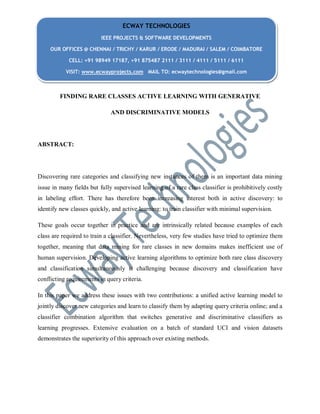Finding rare classes active learning with generative and discriminative models
- 1. ECWAY TECHNOLOGIES IEEE PROJECTS & SOFTWARE DEVELOPMENTS OUR OFFICES @ CHENNAI / TRICHY / KARUR / ERODE / MADURAI / SALEM / COIMBATORE CELL: +91 98949 17187, +91 875487 2111 / 3111 / 4111 / 5111 / 6111 VISIT: www.ecwayprojects.com MAIL TO: ecwaytechnologies@gmail.com FINDING RARE CLASSES ACTIVE LEARNING WITH GENERATIVE AND DISCRIMINATIVE MODELS ABSTRACT: Discovering rare categories and classifying new instances of them is an important data mining issue in many fields but fully supervised learning of a rare class classifier is prohibitively costly in labeling effort. There has therefore been increasing interest both in active discovery: to identify new classes quickly, and active learning: to train classifier with minimal supervision. These goals occur together in practice and are intrinsically related because examples of each class are required to train a classifier. Nevertheless, very few studies have tried to optimize them together, meaning that data mining for rare classes in new domains makes inefficient use of human supervision. Developing active learning algorithms to optimize both rare class discovery and classification simultaneously is challenging because discovery and classification have conflicting requirements in query criteria. In this paper we address these issues with two contributions: a unified active learning model to jointly discover new categories and learn to classify them by adapting query criteria online; and a classifier combination algorithm that switches generative and discriminative classifiers as learning progresses. Extensive evaluation on a batch of standard UCI and vision datasets demonstrates the superiority of this approach over existing methods.
